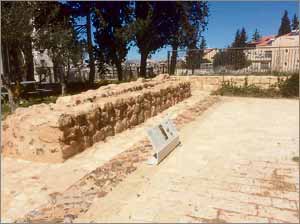 | |||||
| Playground’s hidden secret now providing fun for kids | |||||
EARLY on a Shabbat afternoon in a park in the Jerusalem suburb of Talpiot, families picnic on clipped lawns or fill benches and tables tucked under tall shade-giving trees.
Just metres from their parents, children chase each other, squealing with delight as they clamber over ancient stone and mortar walls, crawl through the round holes hewn in the centre of half a dozen enormous square rocks and peer through smaller apertures between sections of wall. A small boy, yarmulke sitting askew on his head, curly sidelocks swinging to and fro, beats his chest in ‘I’m the king of the castle’-style.
Running through the park, which is almost completely surrounded by high-rise apartment blocks, are large sections of the renovated Jerusalem Aqueduct that 2,000 years ago would have been conveying water to their incredible city through a system awash with ingenuity and engineering brilliance. When the children were thirsty from all their running, climbing and merry making, they rather loudly drank cool water from a nearby water fountain — obviously with no thought of where the water was coming from or how it had got there.
The aqueduct runs along a gentle slope with the water level falling only a metre per kilometre. Initially, the aqueduct was just an open channel, but around 500 years ago, the Ottomans, for better protection of the vital life-supporting flowing water, added a terra cotta pipe to the already existing carrier.
Recognising the huge historical and archaeological importance of the ancient aqueduct, the Israel Antiquities Authority has worked in earnest to expose sections of the aqueduct’s remains, such as those renovated in the Talpiot park and in other areas, while more fragile sections have been reburied for their protection and marked for possible renovation in the future.
A map laid out in concrete at the base of one of the renovated sections of the ancient aqueduct in the park, shows not only the route of the ancient water system, but the route line is indented. With the press of a button inlaid in the ground alongside the map, water begins to flow, filling up the channel at the beginning of the water source, flowing through to the city of Jerusalem. A little girl, dressed in her Shabbat finery, stares at a little dog energetically lapping up water. “Abba, the dog is drinking all the water and there won’t be any left for us,” she cried to her rather amused father.
If you have a story or an issue you want us to cover, let us know - in complete confidence - by contacting newsdesk@jewishtelegraph.com, 0161-741 2631 or via Facebook / Twitter

|




